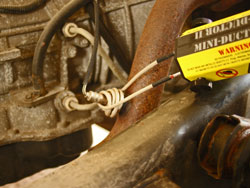Guide: 02 Sensor Removal
Seized O2 sensors are notoriously difficult to remove. If penetrating lube, like PB Blaster, or heating it up with a blowtorch doesn’t work, the next step is usually a nut splitter or cutting it off with a saw. If the non-invasive methods don’t work, you might have to end up either leaving it in or buying a new sensor.
As a result, the process is time consuming, costly and a naked flame can cause irreparable damage to the part and surrounding area.
However, help is at hand. The Mini-Ductor handheld induction heating tool range heats metal parts in seconds using Invisible Heat®.
This allows all types of adhesives bonded to metal, fasteners bonded with thread lock compound, and seized hardware to be removed and released much quicker and safer than by traditional naked flame heating.
Using a torch leads to heat being blown away from the load, wasting its energy and transferring its heat to unwanted areas. With the Mini-Ductor range, nearly all the energy pulled is applied to the load, using invisible heat, making the tool faster and more energy efficient.
The Mini-Ductor heat resistant coils come in different diameters and lengths to suit different nut sizes and a standard preformed work coil or Bearing Buddy (rope style) flexible, coil is ideal for this application.
Step-by-Step Instructions for Removing an O2 Sensor
Equipment needed: heat resistant gloves, overalls, goggles and a respirator mask (if smoke will be produced from heating)
Knowledge required: a well-reviewed proficiency of the tools safety and operating instructions
Using Standard Work Coil
Step 1: select from your coil kit a work coil that will just slightly slide over the sensor and the nut mounting surface on the exhaust pipe, allowing room for expansion when the sensor and nut mounting surface is heated.
Step 2: slide the selected work coil over the sensor/mounting surface and apply induction heat for about ten to twenty seconds (time may vary subject to mass and/or alloy).
Step 3: choose appropriate size wrench for the sensor, slide wrench over sensors nut surface and loosen. (If still too tight repeat steps 2 and 3.)
Using Rope Style Bearing Buddy Coil (BBC)
Step 1: attach one end of BBC to your Mini-Ductor and secure thumb screw. Bring the Mini-Ductor close as possible to the sensor to be removed allowing some room to manipulate the BBC around the sensor.
Step 2: Wrap the BBC around sensor/base with at least three turns capturing as much of the mounting surface as possible. (Make sure you continue winding in the same direction, if not a reverse winding will cancel the induction effect.) Insert opposite end of BBC into the Mini-Ductor and secure thumb screw (double check both screws).
Step 3: Apply induction heat for about 10-20 seconds (time may vary subject to mass and/or alloy). Slide the coil formation back good enough to make room for the wrench. Slide wrench over sensors nut surface and loosen. (If still too tight slide coil formation back over surface and repeat Step-3. (Do not over heat or attempt to turn sensor/surface red hot with the BBC as this will damage the BBC and render it useless.)
Contact us to learn more about removing O2 sensors with induction heating
O2 Sensor Removal with Venom™ Mini-Ductor®

